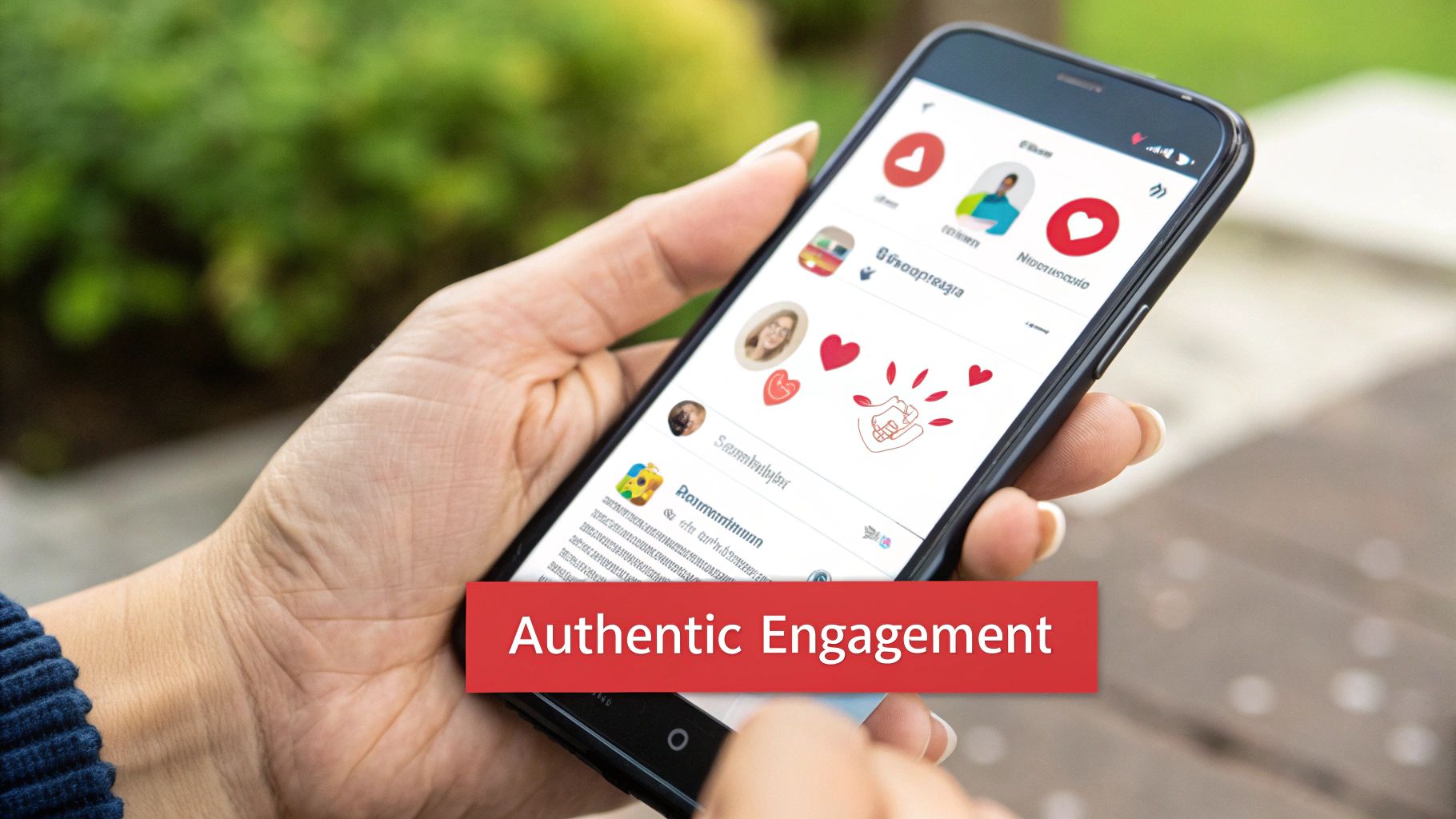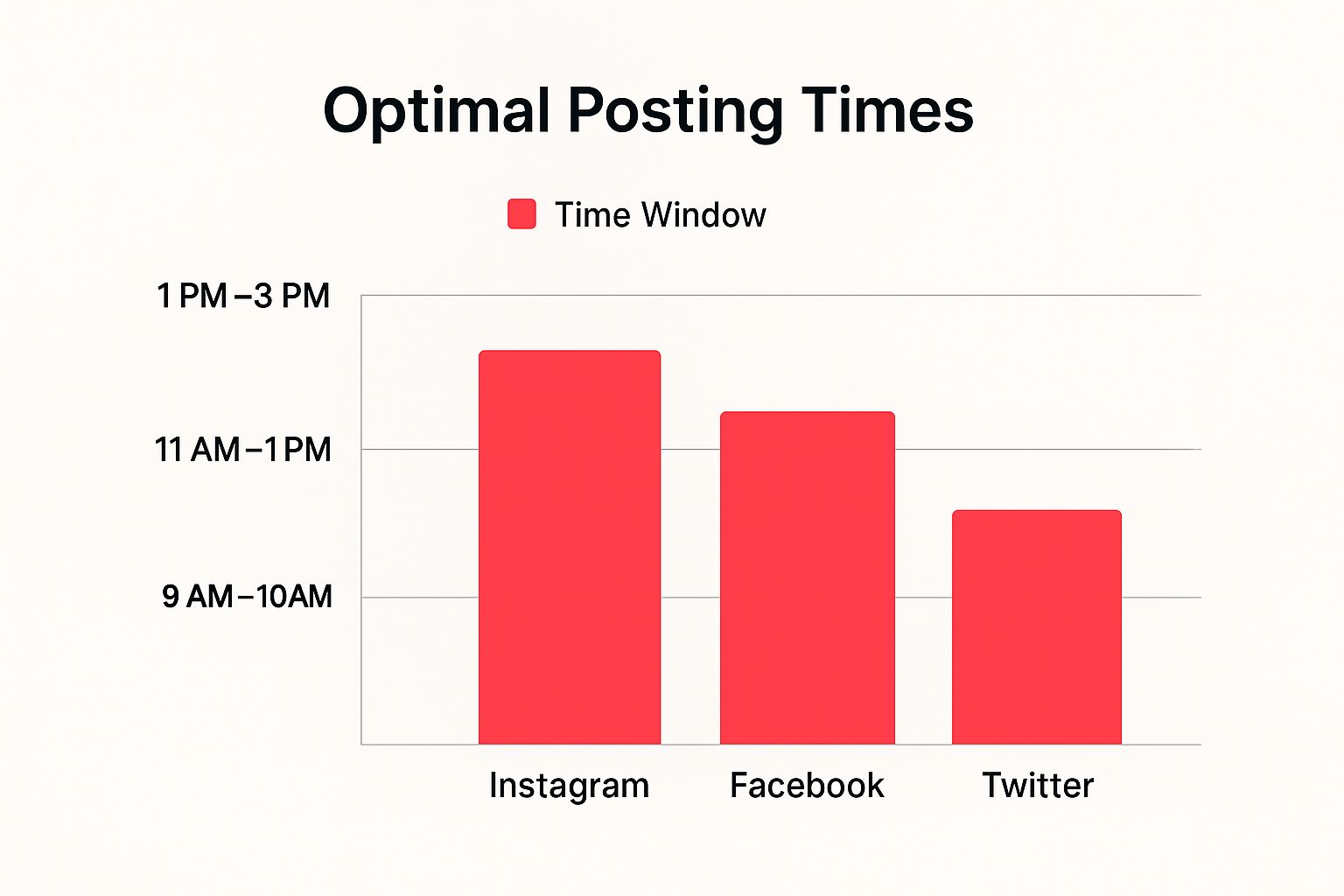In a crowded digital space, effective social media management is more than just posting regularly; it’s a strategic blend of art and science. From engaging your community to analyzing performance, mastering the right techniques can transform your online presence and drive real results. This guide cuts through the noise, offering a blueprint for creators, entrepreneurs, and marketers looking to elevate their strategy from standard to stellar. We will move beyond generic advice and dive straight into actionable, practical steps you can implement immediately.
You'll find a comprehensive collection of social media management tips designed to refine your strategy, streamline your workflow, and maximize your impact. We will cover everything from developing a consistent content calendar and analyzing performance metrics to leveraging user-generated content and maintaining brand consistency. Whether you're managing a YouTube automation channel or building a personal brand on TikTok, these insights are built to be both powerful and easy to apply. Think of this as your roadmap to a more efficient and successful online presence. To kick off your journey to social media mastery, delve into these essential social media manager tips for crushing it in 2025. Now, let's get into the specifics.
1. Develop a Consistent Content Calendar
A content calendar is a strategic roadmap for your social media activity. It’s a schedule where you plan and organize all your upcoming posts in advance, transforming your social media management from a reactive, daily scramble into a proactive, strategic operation. This tool is fundamental for maintaining a steady stream of content, ensuring your brand voice stays consistent, and aligning your posts with key dates, marketing campaigns, and business goals.

This systematic approach is one of the most effective social media management tips because it directly impacts audience engagement and brand reliability. To efficiently develop and maintain a consistent content calendar, establishing a robust modern content creation workflow is essential.
How to Implement a Content Calendar:
- Start with a Monthly Overview: Map out major holidays, industry events, product launches, and company milestones for the upcoming month.
- Break It Down Weekly: Detail specific post topics, formats (image, video, link), captions, and hashtags for each day.
- Use Color-Coding: Assign different colors to platforms (e.g., blue for Facebook, pink for Instagram) or content types (e.g., green for educational, yellow for promotional) for at-a-glance clarity.
- Leave Room for Flexibility: Reserve about 20% of your schedule for timely content, like responding to trending topics or sharing user-generated content. This keeps your feed relevant and dynamic.
By planning ahead, you free up valuable time to focus on community engagement and analyzing performance metrics instead of stressing over what to post next. For a deeper dive into this topic, explore these effective social media content planning strategies.
2. Know Your Audience Demographics and Behavior
Understanding your audience is the cornerstone of all effective social media management tips. It’s the process of researching and analyzing your followers' demographics, interests, online behavior, and platform preferences. This deep knowledge allows you to move beyond generic content and create posts that genuinely resonate, choose the right platforms to invest in, and optimize your schedule for when your audience is most active.
This targeted approach is crucial for building a loyal community and driving meaningful engagement. Brands that excel, like Wendy's with its witty Twitter persona or Spotify with its personalized "Wrapped" campaigns, do so because they have an almost intuitive grasp of what their specific audience wants to see and hear.
How to Understand Your Audience:
- Utilize Native Analytics: Dive into the analytics tools provided by platforms like Instagram Insights, Facebook Audience Insights, and TikTok Analytics. These tools offer a wealth of free data on follower age, gender, location, and peak activity times.
- Create Detailed Personas: Go beyond basic data and build detailed buyer personas. Give your ideal follower a name, job title, and list of pain points and goals. This transforms abstract data into a relatable human profile you can create content for.
- Engage with Polls and Surveys: Don't just guess what your audience wants; ask them directly. Use Instagram Stories polls, Twitter polls, or simple "ask me anything" sessions to gather direct feedback on their preferences and interests.
- Monitor Competitor Audiences: Analyze the followers of your direct competitors. Look at who is engaging with their content and what kind of posts perform best for them. This can reveal market gaps and opportunities for your own strategy.
By investing time in audience research, you ensure your social media efforts are not just loud, but also heard by the right people, leading to higher conversion rates and stronger brand loyalty.
3. Engage Authentically with Your Community
Authentic engagement moves beyond one-way content broadcasting to actively participating in conversations with your audience. This means responding to comments, asking questions, sharing user-generated content (UGC), and building genuine relationships with followers. This approach humanizes your brand, transforming passive viewers into a loyal community that trusts and advocates for your business.

Brands like Taco Bell excel at this, using playful Twitter interactions with both customers and other brands to drive viral engagement and build a relatable persona. This strategy is one of the most powerful social media management tips because it directly fosters brand loyalty and increases organic reach through genuine conversations.
How to Implement Authentic Engagement:
- Respond Promptly and Personally: Aim to reply to comments and direct messages within a few hours. Use the person's name to create a personal connection and show you value their input.
- Ask Open-Ended Questions: Instead of just posting statements, ask questions in your captions that encourage thoughtful responses and spark a dialogue among your followers.
- Feature User-Generated Content: Regularly share and give credit to content created by your audience. This not only provides you with authentic content but also makes your community members feel seen and appreciated.
- Show Appreciation: Go beyond a simple "like" by actively thanking loyal community members for their support, creating a positive feedback loop that encourages continued interaction.
By focusing on real, two-way communication, you build a strong foundation of trust and create an environment where your audience feels connected to your brand on a personal level.
4. Use High-Quality Visual Content
In the fast-paced world of social media, high-quality visuals are your most powerful tool for stopping the scroll. Since the human brain processes images 60,000 times faster than text, strong visual content is non-negotiable for effective communication and engagement. This includes everything from professional photography and well-designed graphics to compelling videos that reflect a cohesive brand identity.

Investing in superior visuals is one of the most impactful social media management tips because it directly boosts brand perception and audience interaction. Brands like Airbnb master this by using stunning professional photos to sell an experience, not just a rental. Similarly, GoPro leverages dynamic user-generated videos to showcase its products in authentic, action-packed scenarios. High-quality visuals make your message more memorable and significantly increase performance across all platforms.
How to Implement High-Quality Visuals:
- Establish Visual Guidelines: Maintain consistency by using the same brand colors, fonts, and logo placement across all your visual assets. This builds brand recognition.
- Prioritize Good Lighting: When shooting photos or videos, use natural light whenever possible. It creates a cleaner, more professional look without expensive equipment.
- Optimize for Each Platform: Resize and format your images and videos according to each social media channel’s specific requirements to avoid awkward cropping or low resolution.
- A/B Test Your Styles: Experiment with different visual formats, such as infographics versus lifestyle photos or short-form videos versus static posts, to see what resonates most with your audience.
By elevating your visual content, you create a more professional and engaging feed that captures attention and effectively communicates your brand's value. This strategic focus ensures your content doesn't just get seen; it gets remembered.
5. Monitor and Analyze Performance Metrics
Monitoring and analyzing social media metrics is the process of turning raw data into actionable insights. It’s about looking beyond simple likes and followers to understand what content resonates, drives traffic, and achieves business objectives. This data-driven approach transforms your social media management from guesswork into a calculated strategy, allowing you to optimize performance, justify your efforts, and prove ROI.
This practice is one of the most crucial social media management tips because it closes the feedback loop, informing your future content and strategy. To effectively monitor and analyze performance metrics, consult an comprehensive ultimate guide to social media marketing analytics for detailed techniques.
How to Analyze Performance Metrics:
- Focus on Key KPIs: Don't get lost in vanity metrics. Select 3-5 key performance indicators (KPIs) like engagement rate, click-through rate (CTR), and conversion rate that directly align with your business goals.
- Use UTM Parameters: Track exactly how much traffic and how many conversions your social media channels are driving to your website by adding UTM codes to your links.
- Compare and Contrast: Analyze performance across different platforms, content formats (e.g., video vs. static image), and campaign types to identify what works best where.
- Generate Regular Reports: Create weekly or monthly performance summaries to spot trends, measure progress against goals, and make informed adjustments to your strategy. For example, Netflix analyzes engagement data to tailor show promotions for each platform.
By consistently reviewing your analytics, you can stop wasting resources on ineffective tactics and double down on what truly moves the needle. To see how this applies to a specific platform, learn how to unlock TikTok account analytics to boost your content.
6. Optimize Posting Times and Frequency
Timing is crucial in social media management as it determines when your audience is most likely to see and engage with your content. Simply creating great content isn't enough; you must deliver it when your followers are most active. This involves researching when your specific audience scrolls through each platform and adjusting your posting schedule to maximize organic reach, engagement, and overall performance without overwhelming their feeds.
The following bar chart visualizes common peak engagement windows for several major social media platforms.

This data highlights how user activity varies significantly by platform, emphasizing why a one-size-fits-all posting schedule is ineffective for social media management.
How to Optimize Your Posting Schedule:
- Test and Measure: Experiment with different posting times for 2-3 weeks. Use your platform's native analytics to identify when your followers are most active and which posts earn the highest engagement.
- Adjust Frequency by Platform: Your posting cadence should match the platform's culture. Twitter's fast-paced environment allows for multiple posts per day, while platforms like LinkedIn or Instagram favor less frequent, higher-quality content.
- Consider Time Zones: If you have a global or national audience, schedule key posts to align with peak hours across different time zones to maximize visibility.
- Prioritize Quality Over Quantity: Never sacrifice the quality of your content just to meet a frequency target. A single, high-impact post is far more valuable than multiple mediocre ones.
Optimizing your schedule ensures your hard work gets the attention it deserves. To master timing on one of today's most dynamic platforms, you can explore these tips for the best time to post on TikTok.
7. Maintain Brand Consistency Across All Platforms
Brand consistency is the practice of ensuring your brand identity, voice, and core messaging remain uniform across every social media channel. While the content format may adapt to each platform’s unique audience and features, your fundamental personality should not. This uniformity is what builds brand recognition, fosters audience trust, and creates a cohesive experience, making it a critical social media management tip for long-term growth.
Think of how brands like Apple maintain a minimalist aesthetic and innovative tone from Instagram to Twitter, or how Old Spice’s distinct humor is instantly recognizable everywhere. This consistency makes them memorable and reliable. A disjointed brand presence, where you sound formal on LinkedIn but use slang on TikTok, can confuse your audience and weaken your brand's impact.
How to Maintain Brand Consistency:
- Create Detailed Brand Guidelines: Document everything from your logo usage, color palette, and fonts to your brand's tone of voice. Define your personality (e.g., witty, inspiring, formal) and provide examples of what to say and what to avoid.
- Use Consistent Visuals: Your profile picture and cover photos should be the same or thematically similar across all platforms. This is often the first visual cue a user gets.
- Develop Platform-Specific Templates: Create content templates for different platforms (e.g., Instagram Stories, YouTube thumbnails) that incorporate your brand's core visual elements, ensuring a consistent look and feel even with varied content.
- Conduct Regular Audits: Periodically review all your social media profiles to check for inconsistencies. Ensure that all team members are aligned with the brand voice and that your messaging still reflects your core values.
By establishing and enforcing brand consistency, you make your brand instantly recognizable and trustworthy, no matter where potential customers find you online.
8. Leverage User-Generated Content (UGC)
User-generated content (UGC) is a powerful social media management tip that involves sharing content created by your audience, customers, and brand advocates. This authentic content, such as customer photos, reviews, testimonials, and videos featuring your brand, acts as powerful social proof. It builds a genuine community, provides a steady stream of cost-effective content, and significantly boosts trust and credibility with potential customers.
This strategy turns your audience into brand ambassadors, creating a self-sustaining cycle of engagement. Brands like GoPro and Starbucks have built massive communities by masterfully showcasing customer adventures and creative seasonal photos. This approach is one of the most effective social media management tips for fostering an authentic brand image.
How to Leverage UGC:
- Create a Branded Hashtag: Launch a unique and memorable hashtag to encourage followers to tag their content. This makes it easy to find, track, and curate submissions for your feed.
- Always Ask for Permission: Before reposting any user's content, reach out and ask for their explicit permission. It shows respect and protects you legally. Always give credit by tagging the original creator in your post.
- Offer Incentives: Motivate your audience to participate by running contests, offering discounts, or featuring the best submissions on your profile. A simple feature can be a powerful motivator for creators.
- Showcase and Engage: Feature UGC prominently across your social media profiles and website. Actively engage with every user who creates content for your brand by liking, commenting, and thanking them to encourage future participation.
9. Stay Updated with Platform Changes and Trends
Social media platforms are not static; they are constantly evolving with new features, algorithm updates, and emerging content trends. Staying current is one of the most vital social media management tips because what worked yesterday might not work tomorrow. Adapting your strategy to these changes ensures your content remains visible, engaging, and effective, preventing your brand from becoming irrelevant.
This proactive approach allows you to leverage new opportunities before your competitors. For example, brands that quickly adopted Instagram Reels upon its launch saw significant organic reach. Similarly, when Facebook’s algorithm shifted to prioritize "meaningful social interactions," businesses that adjusted their content to foster conversation maintained their performance while others saw a decline. Staying informed is a non-negotiable part of modern social media strategy.
How to Stay Updated:
- Follow Official Sources: Regularly check the official blogs and newsrooms of the platforms you use (e.g., the Instagram Blog, Facebook Newsroom). These are the primary sources for feature announcements and policy changes.
- Join Industry Communities: Engage with marketing forums, Slack channels, or Facebook groups dedicated to social media. These communities, often highlighted by resources like Social Media Examiner, are great for real-time discussions on algorithm shifts.
- Test New Features Early: When a platform rolls out a new feature like LinkedIn Stories or YouTube Shorts, experiment with it immediately. Early adopters often benefit from increased visibility as the platform pushes its new tool.
- Evaluate Trends Carefully: Not every trend is right for your brand. Before jumping on a viral meme or challenge, assess whether it aligns with your brand voice and audience. The goal is relevance, not just participation.
10. Implement a Crisis Management Plan
A social media crisis management plan is a proactive strategy for handling negative feedback, PR disasters, or viral criticism. It outlines precise steps, communication protocols, and escalation paths to protect your brand’s reputation when things go wrong. Having this plan ready transforms a potential catastrophe from a chaotic scramble into a managed response, allowing you to act quickly and decisively.
This preparation is one of the most crucial social media management tips because it can prevent lasting brand damage. A well-executed response, like those seen from brands such as Wendy's or JetBlue, can even turn a negative situation into a demonstration of accountability and customer care. A solid crisis plan is a non-negotiable part of a comprehensive social media strategy.
How to Implement a Crisis Management Plan:
- Develop Response Templates: Create pre-approved message templates for common negative scenarios like service outages, customer complaints, or product issues. This ensures a swift, consistent initial response.
- Establish an Escalation Path: Clearly define who on your team handles what. For example, a minor complaint might be handled by a community manager, while a major PR issue gets escalated to senior leadership.
- Monitor Brand Sentiment: Use social listening tools to continuously track brand mentions and sentiment. Early detection is key to preventing a small issue from snowballing.
- Acknowledge and Take Responsibility: When a mistake happens, the first step should always be to acknowledge the issue quickly and transparently. Avoid deleting negative comments unless they violate community guidelines. Taking ownership builds trust.
By preparing for the worst, you empower your team to handle challenges with confidence, minimizing fallout and reinforcing your brand’s integrity.
Top 10 Social Media Management Tips Comparison
| Strategy | Implementation Complexity 🔄 | Resource Requirements ⚡ | Expected Outcomes 📊 | Ideal Use Cases 💡 | Key Advantages ⭐ |
|---|---|---|---|---|---|
| Develop a Consistent Content Calendar | Medium - initial setup & maintenance | Moderate - planning tools & time | Consistent posting, better campaign coordination | Planning and scheduling across multiple platforms | Ensures consistency, reduces stress, aids collaboration |
| Know Your Audience Demographics and Behavior | High - requires continuous analysis | Moderate to high - analytics tools & data | Targeted content, improved engagement | Audience research, platform targeting | Enables precise targeting, reduces wasted resources |
| Engage Authentically with Your Community | High - ongoing, time-intensive | High - dedicated team and monitoring | Strong brand loyalty, organic reach | Building community, customer service | Builds trust, creates brand advocates |
| Use High-Quality Visual Content | Medium to high - content creation | High - equipment/design skills | Increased engagement, better brand recall | Visual branding, content that requires halt-scroll effect | Significant engagement boost, improved brand image |
| Monitor and Analyze Performance Metrics | Medium - data collection & analysis | Moderate - analytics platforms | Data-driven optimization, ROI demonstration | Strategy refinement, performance tracking | Enables informed decisions, quick strategy pivots |
| Optimize Posting Times and Frequency | Medium - requires research & testing | Low to moderate - scheduling tools | Maximized reach and engagement | Scheduling posts for optimal audience activity | Increases efficiency, improves organic engagement |
| Maintain Brand Consistency Across Platforms | Medium - requires guidelines & training | Moderate - brand materials & audits | Unified brand experience | Multi-platform brand management | Builds recognition and trust, simplifies content creation |
| Leverage User-Generated Content (UGC) | Medium - requires community management | Low to moderate - moderation & incentives | Authentic content, increased reach | Community engagement, social proof campaigns | Cost-effective content, builds trust and engagement |
| Stay Updated with Platform Changes & Trends | Medium to high - constant learning | Low to moderate - time for research | Maintains competitiveness and relevance | Adapting to evolving platforms and algorithms | Early feature adoption, keeps strategy fresh |
| Implement a Crisis Management Plan | High - detailed planning and training | Moderate to high - team coordination | Quick, appropriate crisis response | Managing PR issues, mitigating brand reputation risks | Protects reputation, reduces confusion, enables control |
Putting Your Social Media Strategy into Action
Navigating the dynamic landscape of social media can feel like an endless race, but with a structured approach, it becomes a manageable and highly rewarding endeavor. We've explored ten foundational social media management tips designed to transform your online presence from a passive broadcast into an active, thriving community hub. These are not just isolated tactics; they are interconnected components of a powerful growth engine.
Think of it as building a house. Your strategy, anchored by a deep understanding of audience demographics and a consistent content calendar, is the blueprint. High-quality visuals and authentic community engagement are the sturdy walls and welcoming decor that make people want to stay. And just like any well-maintained home, your social media presence requires regular inspection and upkeep. This is where monitoring performance metrics, optimizing post times, and staying updated on platform trends become your essential maintenance tools.
From Theory to Tangible Results
The real magic happens when you move from knowing to doing. The difference between a stagnant account and a flourishing one often lies in the consistent application of these core principles.
- Consistency is Key: Maintaining brand consistency and a reliable posting schedule builds trust and sets expectations. Your audience learns what to expect from you and when, making you a dependable part of their daily feed.
- Adaptability is Your Superpower: Social media is never static. By leveraging user-generated content and being prepared with a crisis management plan, you build resilience. This allows you to adapt to algorithm changes and cultural shifts with agility and confidence.
- Data Drives Decisions: Moving beyond vanity metrics and analyzing what truly resonates with your audience is crucial. The insights you gain from performance data are the most valuable social media management tips you will ever receive, as they are tailored specifically to your community.
Mastering these elements is not about achieving perfection overnight. It is about committing to a continuous cycle of planning, executing, listening, and refining. Each post, every interaction, and all data analysis is a step toward building a more robust, engaging, and ultimately profitable online presence. The goal is to create a digital ecosystem where your brand and your community can grow together, creating a powerful marketing asset that drives real-world results. Remember, the effort you invest in strategic management pays dividends in loyalty, reach, and revenue.
Ready to accelerate your monetization journey? If you want to bypass the initial grind of building an audience from scratch, consider a pre-monetized account from MonetizedProfiles. Their organically grown TikTok and YouTube channels allow you to apply these advanced management tips to a ready-made audience, so you can focus on creating incredible content and generating revenue from day one.








